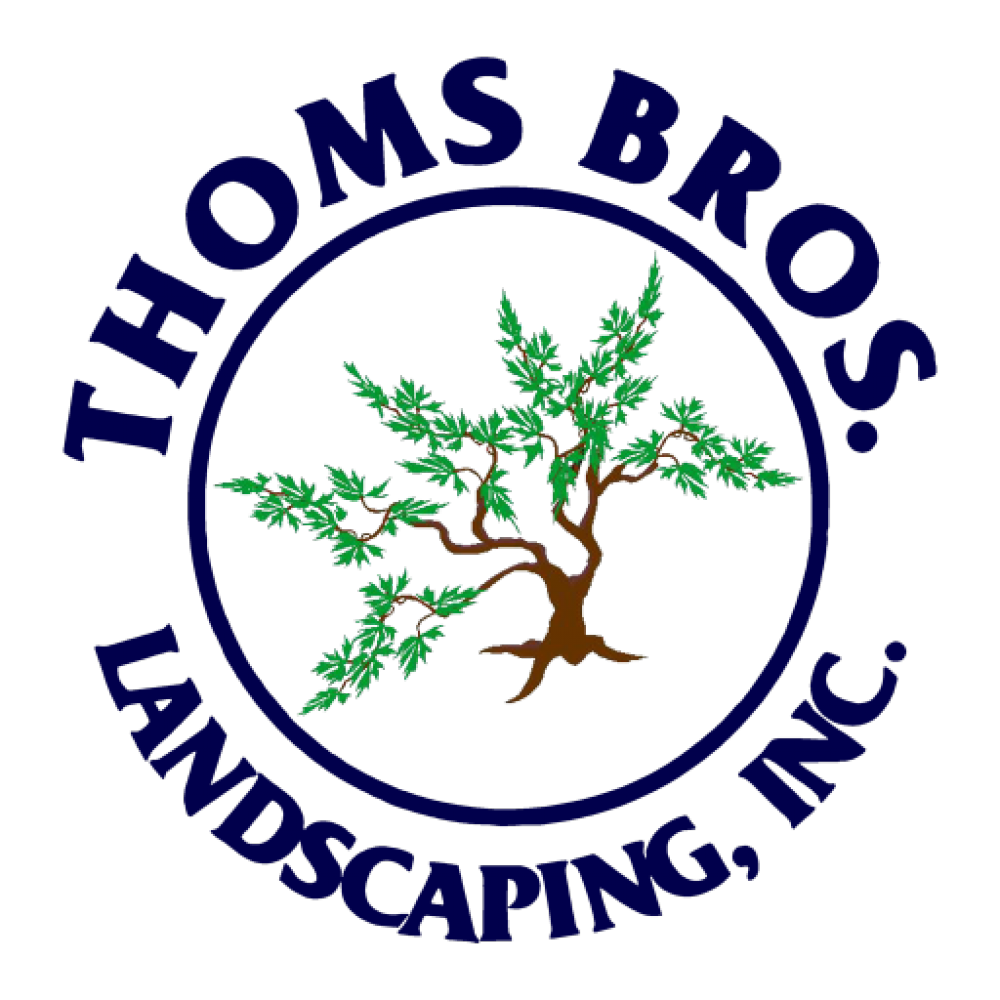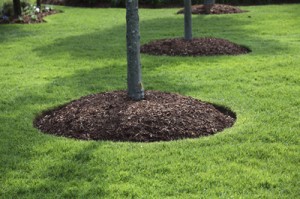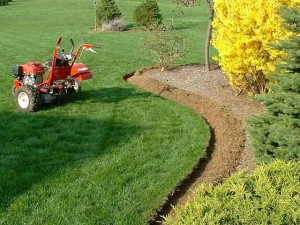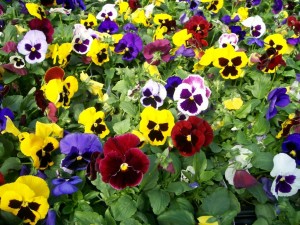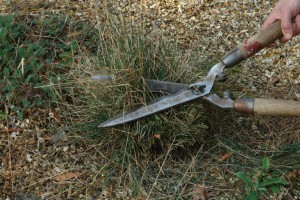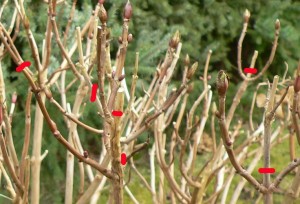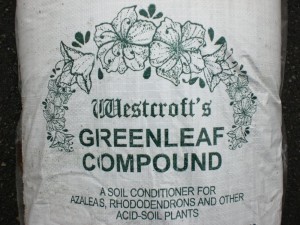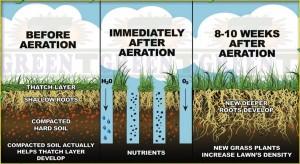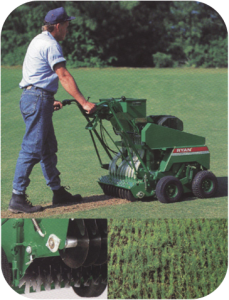Yah! Spring has finally arrived here in Southeast Michigan. The grass is starting to green up, buds are swelling on trees and shrubs and perennials are popping out of the ground. So how do you prepare your landscape for the upcoming season? We hope these tips will help you out if you are doing these tasks yourself or looking to hire a landscape contractor.
Planting Beds
- Blow, rake and/or physically clean out debris from your beds. With large beds, decorative stone beds and/or beds with groundcovers usually the easiest way to clean out is with a powerful enough blower. Dirt only beds might need the dirt physically turned over with a shovel or cultivator. Shredded bark beds also need to be turned over and loosen the hard top surface. Even if installing new bark if the old bark has crusted surface it needs to be broke.
- Adding new mulch is a preference thing. It should be done every or every-other year. If budget and/or time is a constraint every-other year could be option, but recognizing that controlling weeds could be more difficult on the second season. Just remember though, mulch depths should be about four inches. On average, two inches a year decomposes. So if you are on a bi-yearly schedule you will need to install more mulch.
- Mulching around trees has become quite an issue over the last several years. Mulch should NOT be applied above the flare of the trunk. The root flare is the portion to the tree where the trunk widens at the base as it transitions to the root system. This flare occurs at the natural grade of the soil. It is of critical importance that this level be maintained. So a mulch volcano should be avoided at all cost!
- Pre-emergent weed control can be added to beds to help prevent weed germination. This will not control any weeds that are already rooted in the bed. So, if there are still weeds leftover from the previous season, these should be pulled or sprayed with a post-emergent such as round up. Careful application should be taken to avoid overspray onto desired plants. One thing to consider is that some weeds will become resistant to pre-emergents if they are added every year to the planting beds.
- If you do not have something (plastic, steel or aluminum edging or retaining walls) to separate the beds from the turf, a spade (or machine) cut bed edge defines the bed and puts the finishing touch on the landscape. If adding mulch to the beds, using a spade to push back soil and old mulch from concrete/paver sidewalks and drives will help prevent new mulch from being washed onto the surface.
- Except for cold weather annuals (i.e. pansies, etc.), these types of plant material should not be planted until frost is not possible. The rule of thumb is around Memorial Day (late May). Alternatively, you can find out when the projected last frost date is in your area by checking with your local county extension office.
Herbaceous Ornamental Plants (perennials, ornamental grasses and ground covers)
- If mulch was heavily applied over the root system for the cold season, this should be carefully pulled back.
- If (non evergreen) perennials and ornamental grasses were not cut back in the fall, they should be done before new growth shows. For some plant material such as daylilies and hostas, it might just take a hand to pull it from the ground. Some other species, such as peony and Black Eye Susan might need pruners to cut the stalks. For ornamental grass, we use powered or hand hedgers to cut as low as possible.
- Most groundcovers will just need a good raking over to pull out any dead branches, leaves and debris.
- Spring flowering bulbs should be left alone until the leaves are yellow. Then at that time they can be removed and a bulb fertilizer is usually recommended.
- Vines (such as clematis) should have dead branches pruned off.
- New plants can be installed as long as there is no chance for a heavy freeze. Here in Southeast Michigan we are pretty much in the clear of that danger.
Shrubs
- If physical winter protection was installed in the fall, this should be removed immediately.
- Dead branches should be removed in most cases. Sometimes certain evergreens will have brown leaves from winter damage, do NOT remove these yet. Many times these branches will produce new leaves/needles. The smartest way to check is to prune at the tip of a branch in search of green cambium. If brown, continue cutting back until green or you reach an intersection.
- All new type landscape roses (Carpet, Knock Out, Oso Easy, etc.) should be cut back six to twelve inches from the ground. This will promote a thick and healthy plant.
- Hydrangeas should not be cut back in the Spring as they have produced many if not all of their flower buds in the previous fall. Arborscens or Smooth (Annabelle, Incrediball, etc) and paniculata or Hardy (Limelight, Quickfire, etc.) Hydrangeas flower on new wood, so you can get by pruning lightly, but to control size major pruning should take place in fall or early winter. Macrophylla or Bigleaf and quercifolia or Oakleaf Hydrangea flower on old wood so no pruning should be done unless the branch is dead. Then pruning back to the next live bud might be necessary because of winter damage. To control size, major pruning should be done in June or July.
- Most shrubs should not need any fertilizer in the Spring. If needed, this should be done in the late fall. The one exception could be acid loving plants. On rhododendrons, azaleas, etc. Thoms Bros. uses a product out of Westcroft Gardens called Greenleaf Compound. We apply it to flowering plants in spring before they bloom, right after they bloom and again one more time in the fall.
Turf
- Debris (leaves, branches, etc.) should be removed as soon as possible from your lawn.
- If the lawn was left long in the fall, cutting would be recommended.
- Any bare spots that were killed by winter or from the previous season, can be raked and seeded. A seeding mulch is usually recommended. Pre-emergent (crab grass control) should be avoided in these locations as they will prevent seed from germinating. Adding some soil to the areas might help as well.
- A pre-emergent weed control should already have been or quickly applied to prevent crab grass from germinating. A light fertilizer can also be done at this point but usually is not needed if a heavy late fall fertilizer application was completed the year before.
- Pink or gray snow mold should also be raked off the lawn and seeded. A fungicide is not recommended as the disease has already did its damage.
- Aeration of the lawn is recommended for turf that has heavy soil (clay) and/or heavy traffic. Grass needs water and air in order to grow. When soil is compacted, water and air do not get to the grass. Aeration involves poking holes in the soil with an aerator, by which water and air can better circulate and stimulate growth. Aeration should take place in the early Fall as to prevent undesired weed germination but can be done in May when ground is warm enough but drought isn’t a problem.
- Overseeding/slit seeding is the practice of spreading grass seed over an existing lawn. This can either be done by hand/spreader or using a machine that actually slits into the existing turf/soil. The obvious need to overseed is when your grass is thin. But keeping your lawn young by overseeding every so many years will keep it fresh and thick. Be aware though, turf can be thin because of too much shade and root competition from trees. Even though there is some shade “tolerate” turf species, no grass likes deep shade. Overseeding would only be a temporary fix. If a lawn is really in rough condition, it can be overseeding in the same time frame as aeration..May. But the best time of season is late summer/early fall.
- Irrigation should not be needed for at least another month. When we get our first full week of no precipation is when you should consider turning on the sprinkler system. Please do not let your irrigation contractor start up and program your system and leave it like that for the season. if you do not have a weather and/or web based irrigation controller, you should adjust the amount of water your system puts done based on the season and weather patterns.
